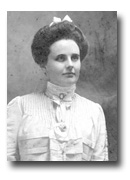



There are several key locations where family members either spent more time or where important events occurred. On the western end of Long Island and the nearby counties of New Jersey, several families had their origins and resided there for some time - the Simpson, Sayre and Winget families are in this group. Members of these three families migrated to Washington County, Pennsylvania, both during and after the Revolutionary War. In western New Jersey the Stoy family lived in Gloucester County (which split into Camden County in 1844) and some of the family are still in the area. The Caylor family lived in Loudoun County, Virginia, since the late 1700s, as did the Oatyar/Etcher family. Both the Caylor and Stoy families, on my direct line, moved to Fairfax County in the late 1800s and members of both families still live in Northern Virginia.
The table below describes the paternal locations, the families involved, the time period they were associated with, the location and the number of years spent in the area. This information applies only to people on the direct paternal line - many of the non-direct family members remained in some of these areas well into the 20th Century. One easy way to trace people is to go to the Database page and click on the Master Place Index to see what people are associated with which place.
| Paternal Family | ||||
| State | County | Surname | Time Period | # Years |
| Maryland | St Mary's | Edwards | 1710-1810 | 100 |
| New Jersey | Essex/Union | Sayre | 1670-1760 | 90 |
| Simpson | 1720-1780 | 60 | ||
| Gloucester/Camden | Stoy | 1770-1870 | 100 | |
| Morris | Winget | 1740-1780 | 140 | |
| Somerset | Sayre | 1760-1790 | 30 | |
| New York | Kings | Sayre | 1790-1820 | 30 |
| Simpson | 1660-1720 | 60 | ||
| Pennsylvania | Washington | Sayre | 1790-1820 | 30 |
| Simpson | 1780-1820 | 40 | ||
| Winget | 1780-1820 | 40 | ||
| Virginia | Fairfax | Caylor | 1870-1940 | 70 |
| Stoy | 1870-2000 | 130 | ||
| Loudoun | Caylor | 1770-1870 | 100 | |
| Edwards | 1800-1900 | 100 | ||
| Oatyar | 1770-1840 | 70 | ||
| Stafford | Primm | 1740-1800 | 60 | |
Families on the maternal line were from the South or the border state of West Virginia. The Alley family began in Virginia before the Revolutionary War, moved briefly to North Carolina, then to Habersham County, Georgia - many of this family remained in North Carolina. The Rudd family also began in Virginia then migrated to McMinn County, Tennessee, then to Hamilton County (Chattanooga, where many Rudds still live). The Young family had its beginnings in Virginia, then migrated to Tennessee and then further to north Georgia in the early 1800s, then to Hamilton County, Tennessee, then to Washington, DC. Both the Fleming and Morrison families came from Scotland and Ireland, respectively, in the early- to mid-1800s and settled in Wheeling, Virginia (now West Virginia) with some of the family still living in the area.
| Maternal Family | ||||
| State | County | Surname | Time Period | # Years |
| District of Columbia | Young | 1920-1960 | 40 | |
| Georgia | Chattooga | Simmons | 1840-1880 | 40 |
| Habersham | Alley | 1820-1870 | 50 | |
| Murray | Young | 1850-1870 | 20 | |
| Walker | Young | 1880-1890 | 10 | |
| Tennessee | Washington | Young | 1770-1850 | 80 |
| McMinn | Rudd | 1790-1870 | 80 | |
| Hamilton | Rudd | 1890-1920 | 30 | |
| Young | 1890-1920 | 30 | ||
| Virginia | Augusta | Young | 1740-1770 | 30 |
| Brunswick | Alley | 1740-1780 | 40 | |
| Mecklenburg | Rudd | 1740-1790 | 50 | |
| West Virginia | Ohio | Fleming | 1850-1920 | 70 |
| Morrison | 1840-1920 | 80 | ||
Comparing the two direct family lines, the maternal families seemed to move around more, staying in one place for less time than the paternal families. There appear to be several reasons; for example, my maternal grandfather left north Georgia about 1900 with his siblings because of the death of his mother in the 1890s and the apparent death of his father a bit later. They moved to Chattanooga, the nearest large city where employment was easy to find (it was a significant rail center) and where other family members had moved earlier. He followed railroad employment opportunities for the rest of his life. The movement of some of the Rudd family from McMinn County, where they had lived for many years, to Chattanooga was likely driven by employment opportunities for Milton Rudd, a telegraph operator for most of his life.